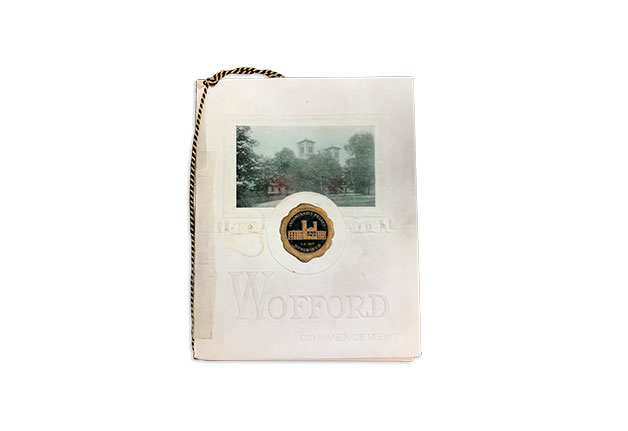In its earliest years, Commencement season, as Dr. Henry Nelson Snyder called it in one letter, lasted for several days. In addition to the formal exercises in which the president and faculty conferred degrees on the graduates, a series of lectures, receptions, debates and other events marked the transition of a group of students into alumni.
Some of the college’s Commencement traditions date to the earliest years, such as the presentation of a Bible, signed by the faculty, to each graduate. The traditional Commencement hymn “From All That Dwell Below the Skies” appears as early as the 1860 Commencement program. Most of the Commencement programs up through 1875 were printed in Latin, so it must have been a shock in 1876 for guests to find the program printed in English. One tradition that was abandoned in the late 19th century was the presentation of Commencement addresses by each student. Hearing more than two dozen student addresses might have been more than even the most receptive audience could stand.
The late-19th-century Commencement season lasted three or four days. The festivities included a Baccalaureate sermon, often on Sunday; an address before the literary societies, often on Monday; a joint debate between members of the two literary societies and a large reception afterward. Each society held a graduation ceremony for its members. Commencement was on Tuesday, featuring the student addresses. Later that day, the alumni association would sponsor an address, and another reception that evening would go well after midnight. The receptions for the Class of 1886 on the night before and night of Commencement ran from 10 p.m. to 2 a.m.
In the early 20th century, Commencement week often featured class reunions, and an alumni-senior banquet became a regular event. We somewhat reflect that today in having the 50-year class join the graduates at Baccalaureate and Commencement. The 1910 exercises ran from Friday to Monday, with a Glee Club concert on the first night, a literary society debate on Saturday, sermons and addresses and receptions on Sunday, and the conferring of degrees on Monday morning, followed by the alumni address at 8:30 p.m. and banquet, which started at 10 p.m.
A series of events spread over three or four days made sense in a slower-paced early 20th-century society. Today, we spread some events out over several weeks, with various organizations having final presentations, parties and recognitions throughout April and May. However, we’ve held fast to a commitment to make the events around graduating from Wofford special and memorable for everyone involved.
By Dr. Phillip Stone ’94, college archivist
